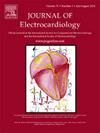一种新的预定位序列算法在鉴别宽QRS复杂心动过速中的应用分析
IF 1.3
4区 医学
Q3 CARDIAC & CARDIOVASCULAR SYSTEMS
引用次数: 0
摘要
背景宽QRS复杂性心动过速(WCT)的准确诊断对进一步诊断和治疗具有重要的临床价值。目的评价一种新的WCT鉴别算法——预定位序列算法,该算法包括室性心动过速(VT)与室上性心动过速(SVT)的序列鉴别和室性心动过速(VT)与预兴奋性心动过速(PXT)的序列鉴别。方法对185例WCT患者的心电图进行回顾性分析,采用预定位单过程算法(区分VT与SVT,不区分VT与PXT)、预定位序列算法、肢体导联算法和巴塞尔算法。心电图分为室速和室速。预定位序列算法进一步将初步诊断的VT区分为VT或PXT,并将结果与确诊的诊断结果进行比较,评估四种算法的诊断价值。结果与肢体导联算法和巴塞尔算法相比,预定位单过程算法具有更高的AUC值(0.777 vs 0.711 vs 0.646)、灵敏度(0.955 vs 0.809 vs 0.745)和准确性(0.811 vs 0.730 vs 0.665)。预定位序列算法的AUC值(0.901 vs 0.711 vs 0.646)、灵敏度(0.909 vs 0.809 vs 0.745)、特异性(0.893 vs 0.613 vs 0.547)、准确性(0.903 vs 0.730 vs 0.665)均高于肢体导联算法和巴塞尔算法,特异性(0.893 vs 0.600)和准确性(0.903 vs 0.811)均高于预定位单流程算法,但灵敏度(0.909 vs 0.955)略低于预定位单流程算法。差异有统计学意义(P <;0.05)。结论与肢体导联算法和巴塞尔算法相比,单步预定位算法具有更高的灵敏度和准确性。序列算法由于特异性提高,进一步增强了诊断价值,可考虑用于诊断VT、SVT、PXT。本文章由计算机程序翻译,如有差异,请以英文原文为准。
Application analysis of a new pre-localization series algorithm for differentiating wide QRS complex tachycardia
Background
Accurate diagnosis of wide QRS complex tachycardia (WCT) holds significant clinical value for further diagnosis and treatment.
Objective
To evaluate a new WCT differentiation algorithm, defined as the pre-localization series algorithm, which includes the series process for differentiating ventricular tachycardia (VT) from supraventricular tachycardia (SVT) and differentiating VT from preexcited tachycardia (PXT).
Methods
A retrospective analysis of electrocardiograms (ECGs) from 185 patients with WCT was conducted using the pre-localization single-process algorithm (differentiating VT from SVT without differentiating VT from PXT), the pre-localization series algorithm, the limb lead algorithm, and the Basel algorithm. The ECGs were differentiated into VT or SVT. The pre-localization series algorithm further differentiated the initially diagnosed VT into VT or PXT, and the results were compared with the confirmed diagnoses to assess the diagnostic value of the four algorithms.
Results
The pre-localization single-process algorithm had higher AUC values (0.777 vs. 0.711 vs. 0.646), sensitivity (0.955 vs. 0.809 vs. 0.745), and accuracy (0.811 vs. 0.730 vs. 0.665) compared with the limb lead algorithm and the Basel algorithm. The pre-localization series algorithm had higher AUC values (0.901 vs. 0.711 vs. 0.646), sensitivity (0.909 vs. 0.809 vs. 0.745), specificity (0.893 vs. 0.613 vs. 0.547), and accuracy (0.903 vs. 0.730 vs. 0.665) compared with the limb lead algorithm and the Basel algorithm, the pre-localization series algorithm also had higher specificity (0.893 vs. 0.600) and accuracy (0.903 vs. 0.811) than the pre-localization single-process algorithm, but sensitivity(0.909 vs. 0.955) was slightly lower, with statistically significant differences (all P < 0.05).
Conclusion
The pre-localization single-process algorithm had higher sensitivity and accuracy compared with the limb lead algorithm and the Basel algorithm. The series algorithm, due to its improved specificity, further enhanced diagnostic value and can be considered for diagnosing VT, SVT, and PXT.
求助全文
通过发布文献求助,成功后即可免费获取论文全文。
去求助
来源期刊

Journal of electrocardiology
医学-心血管系统
CiteScore
2.70
自引率
7.70%
发文量
152
审稿时长
38 days
期刊介绍:
The Journal of Electrocardiology is devoted exclusively to clinical and experimental studies of the electrical activities of the heart. It seeks to contribute significantly to the accuracy of diagnosis and prognosis and the effective treatment, prevention, or delay of heart disease. Editorial contents include electrocardiography, vectorcardiography, arrhythmias, membrane action potential, cardiac pacing, monitoring defibrillation, instrumentation, drug effects, and computer applications.
 求助内容:
求助内容: 应助结果提醒方式:
应助结果提醒方式:


